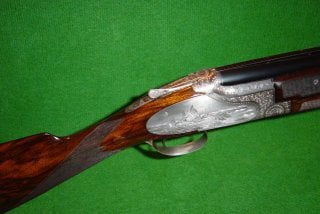Browning Citori – Not Just a Poor Man’s Superposed
While new models have been produced, a true Superposed from either of the earlier eras is much like a classic car—something often unobtainable due to the costs.
For fans of the “over-and-under” or “stacked-barrel” type shotgun, the Browning Superposed remains the firearm on which all others in the category are judged. It was the first over and under shotgun design to be produced and was based on a concept by legendary firearms designer John Moses Browning going back to the 1880s.
The Superposed was the last firearm designed by John Browning, and after his death, the work was completed by his son Val A. Browning, and the original production of the shotgun only ran from 1931 to 1940, followed by postwar production that started in 1948 and lasted until 1960. While new models have been produced, a true Superposed from either of the earlier eras is much like a classic car—something often unobtainable due to the costs.
However, since 1973 Browning has offered the more affordable Citori and while it is considered by some to be the “poor man’s version” of the Superposed it is no bargain-basement shotgun. In fact, the Citori was originally made by Fabrique Nationale in Belgium to address rising production costs that put the Superposed out of the price range of the average shotgunner. Yet it still maintained the high-quality reputation of the more expensive Superposed.
The Citori features many of the qualities that shooters simply expect from the Browning brand. This includes tight wood-to-metal fit, while action components are machined to exacting tolerances, heat-treated for greater strength, and fitted using the traditional lampblack-and-file method, which ensures a precise fit of critical components.
Quality Components
The Citori line is available in nearly all of the popular shotgun shell gauges including 12, 16, 20, 28 and .410 bore; while barrel lengths range from 24 to 32 inches—so the break-action shotgun can be for skeet shooting or for sporting clays and trap shooting.
All of Citori shotguns feature chrome-plated chambers that aids in resisting corrosion and fouling, while the twelve- and twenty-gauge models offer back-bored barrels with slightly larger bore diameters. That is meant to improve shot patterns by reducing the friction of the shot charge on the barrel wall, but it also reduces felt recoil.
A barrel selector allows shooters to choose which barrel fires on the first pull of the single trigger while the second pull fires the remaining barrel. Ejectors are also activated by a sharp hammer blow, which provides a more positive ejection while the automatic ejectors eject fired shells when the breech is opened and elevate unfired shells for easy removal.
For those who take part in competitive shooting, the Citori Sporting Clays, XT and XS Series all come equipped with the Browning Triple Trigger system, which allows the shooter to fine-tune the length of pull and switch between a wide checkered, a narrow smooth and a wide smooth canted trigger shoe.
While John Browning may not have designed the Citori, it is easy to see his influence in the shotgun. Nearly fifty years after its introduction, this shotgun line has remained a popular choice with sport shooters and the Citori 725 was the second-most popular over/under shotguns based on sales on GunBroker.com for 2019 according to the NRA’s American Rifleman. John Browning would likely be pleased.
Peter Suciu is a Michigan-based writer who has contributed to more than four dozen magazines, newspapers and websites. He is the author of several books on military headgear including A Gallery of Military Headdress, which is available on Amazon.com.
Image: Wikimedia Commons / Bertrand Benazeth

